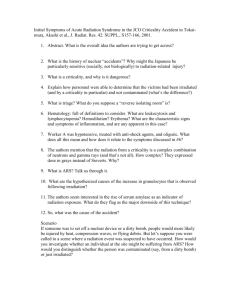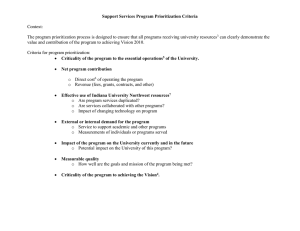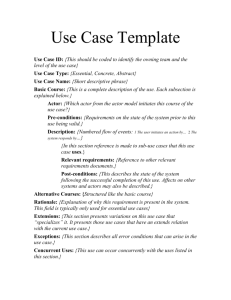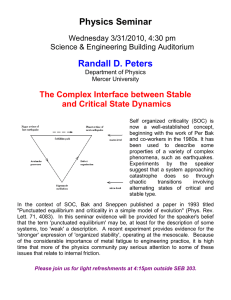Complexity, Criticality and Consciousness. Eight lectures
advertisement
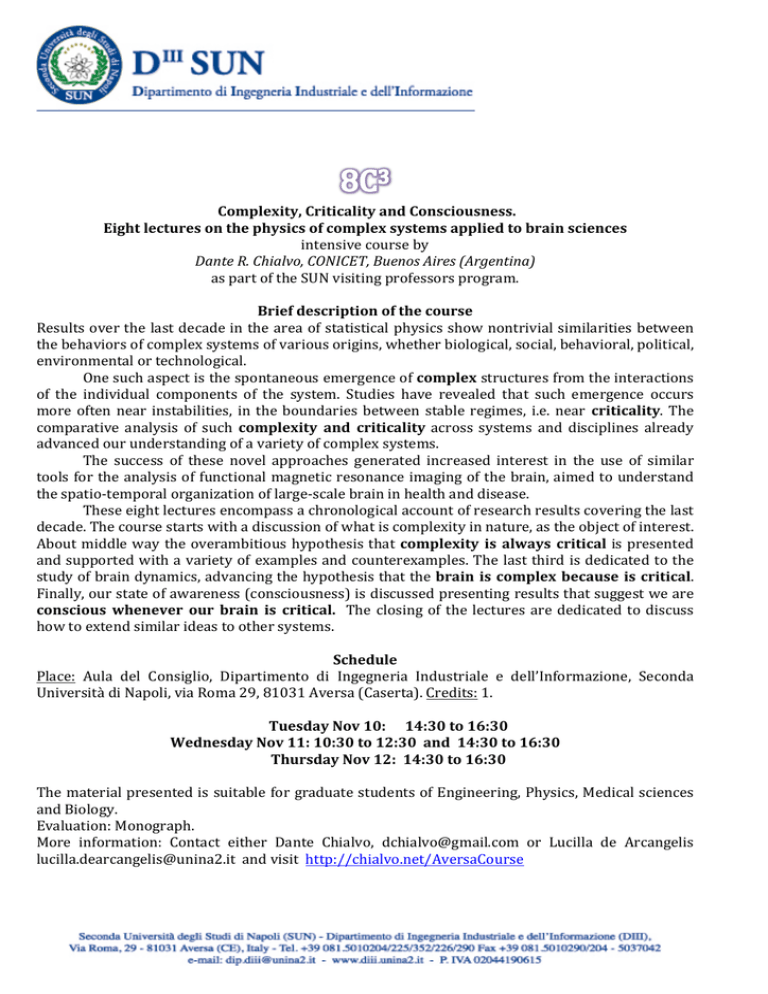
Complexity, Criticality and Consciousness. Eight lectures on the physics of complex systems applied to brain sciences intensive course by Dante R. Chialvo, CONICET, Buenos Aires (Argentina) as part of the SUN visiting professors program. Brief description of the course Results over the last decade in the area of statistical physics show nontrivial similarities between the behaviors of complex systems of various origins, whether biological, social, behavioral, political, environmental or technological. One such aspect is the spontaneous emergence of complex structures from the interactions of the individual components of the system. Studies have revealed that such emergence occurs more often near instabilities, in the boundaries between stable regimes, i.e. near criticality. The comparative analysis of such complexity and criticality across systems and disciplines already advanced our understanding of a variety of complex systems. The success of these novel approaches generated increased interest in the use of similar tools for the analysis of functional magnetic resonance imaging of the brain, aimed to understand the spatio-­‐temporal organization of large-­‐scale brain in health and disease. These eight lectures encompass a chronological account of research results covering the last decade. The course starts with a discussion of what is complexity in nature, as the object of interest. About middle way the overambitious hypothesis that complexity is always critical is presented and supported with a variety of examples and counterexamples. The last third is dedicated to the study of brain dynamics, advancing the hypothesis that the brain is complex because is critical. Finally, our state of awareness (consciousness) is discussed presenting results that suggest we are conscious whenever our brain is critical. The closing of the lectures are dedicated to discuss how to extend similar ideas to other systems. Schedule Place: Aula del Consiglio, Dipartimento di Ingegneria Industriale e dell’Informazione, Seconda Università di Napoli, via Roma 29, 81031 Aversa (Caserta). Credits: 1. Tuesday Nov 10: 14:30 to 16:30 Wednesday Nov 11: 10:30 to 12:30 and 14:30 to 16:30 Thursday Nov 12: 14:30 to 16:30 The material presented is suitable for graduate students of Engineering, Physics, Medical sciences and Biology. Evaluation: Monograph. More information: Contact either Dante Chialvo, dchialvo@gmail.com or Lucilla de Arcangelis lucilla.dearcangelis@unina2.it and visit http://chialvo.net/AversaCourse [Digitare il testo] Detailed content of the lectures: -­‐Initial motivational lecture (Unit 0) Unit 0: How complexity emerges: why these ideas are too important to leave it only to the cognoscenti. -­‐Complexity (Units 1 & 2) Unit 1: Introduction to the sciences of complexity with emphasis on applications in biological, physical sciences and engineering. Unit 2: Complex networks as the “skeleton” of a complex system. How a network can be defined from the flow of interactions between places. Simple examples from social, biological, linguistic, transportations and engineering systems. Concepts of Robustness and Fragility in networks. Static networks and evolving networks. Basics aspects (structural and topological)of networks. The “network zoo”: ordered, disordered, small world, scale free, hierarchical… networks. -­‐Criticality (Units 3, 4, 5) Unit 3: What is a phase transition and what means, for a system, being critical. General notions of critical phenomena. How complexity, in nature, emerges from simplicity. Self-­‐organized criticality. Unit 4: Criticality in the brain. Why the brain shall be critical. Initial experiments in collection of neurons. Neuronal avalanches in brain slices. Models. Further questions Unit 5: Criticality in the brain at large scale. Neuroimaging. Introduction to the physics of magnetic resonance: structural and functional imaging. Introduction to the physiology of magnetic resonance: what measures functional MRI? Advantages and disadvantages of fMRI as a means of recording brain activity. Study of functional and structural connectivity of the human brain. Linear correlation maps based on seeds, triggered averages and point processes. Characterization of large scale dynamics, order and control parameters. -­‐Heuristic metrics of brain states: Consciousness (Unit 6 &7) Unit 6: Mathematical models of the entire brain. Numerical study of phase transitions in neural mass models. Comparison with experimental results obtained with MRI. Unit 7: Altered mind states: Loss of consciousness. How to measure from neuroimaging objectively a given mind state? Discussion of recent results and probable future work in this area. Bibliography General Reading: • Per Bak. How nature works: the science of self-­‐organized criticality. Copernicus, 1999. • Melanie Mitchell. Complexity. A guided tour. Oxford University Press, 2009. • Nino Boccara. Modelling Complex Systems. Springer, 2004. • G. Caldarelli & M Catanzaro. A very short introduction to networks. Oxford University Press (2012). To be discussed in class: • Dante R. Chialvo. Emergent comlex neural dynamics. Nature Physics, 2010. • E. Tagliazucchi and D. R. Chialvo. Brain complexity born out of criticality. AIP Conference Proceedings, 1510(1):4–13, 2013. • Chialvo DR, Gonzalez Torrado AM Gudowska-­‐Nowak E, Ochab JK, Montoya P,Nowak MA,Tagliazucchi E. How we move is universal: scaling in the average shape of human activity. Preprint arxiv.org/abs/1506.06717 • Tagliazucchi E, Siniatchkin M, Laufs H, Chialvo DR. Propofol anesthesia breaks down long-­‐range temporal correlations and the flexible exploration of anatomical connections. (2015) • Tagliazucchi E, Carhart-­‐Harris R, Leech R, Nutt D, Chialvo DR. Enhanced repertoire of brain dynamical states during the psychedelic experience. Human Brain Mapping, (2014). • Haimovici A, Tagliazucchi E, Balenzuela P & Chialvo DR. Brain organization into resting state networks emerges from the connectome at criticality. Physical Review Letters (2013). • Fraiman D. & Chialvo DR. What kind of noise is brain noise: Anomalous scaling behavior of the resting brain activity fluctuations. Frontiers in Fractal Physiology. (2012) • Tagliazucchi E, Balenzuela P, Fraiman D & Chialvo DR. Criticality in large-­‐scale brain fMRI dynamics unveiled by a novel point process analysis. Frontiers in Fractal Physiology. (2012) • Dante R. Chialvo. Emergent complexity: What uphill analysis or downhill invention cannot do. New Ideas in Psychology, 26(2):158 – 173, 2008. • Expert P, Lambiotte R, Chialvo DR, Christensen K, Jensen HJ, Sharp DJ & Turkheimer F. Self-­‐similar correlation function in brain resting-­‐state functional magnetic resonance imaging. Journal of The Royal Society Interface 8, 472-­‐479 (2011). • Chialvo DR. Are our senses critical? Nature Physics 2, 301 (2006). • Eguiluz V, Chialvo DR, Cecchi G, Baliki M, Apkarian AV. Scale-­‐free brain functional networks. Phys. Rev. Letters 92, 018102 (2005). • Pellegrini GL, de Arcangelis L., Herrmann HJ, Perrone-­‐Capano C Activity-­‐dependent neural network model on scale-­‐free networks, Phys. Rev. E, 76, 2007 • Chialvo DR and Bak P. (1999) Learning from mistakes. Neuroscience 90 (4) 1137–1148. Supplementary reading: • Maki-­‐Marttunen V, Diez I, Cortes JM, Chialvo DR, Villarreal M. Disruption of transfer entropy and inter-­‐ hemispheric brain functional connectivity in patients with disorder of consciousness., Frontiers in Neuroinformatics (2013). • Lombardi F, Chialvo DR, Herrmann HJ, de Arcangelis L. Strobing brain thunders: functional correlation of extreme activity events. Chaos, Solitons & Fractals (2013). • Carhart-­‐Harris RL, Leech R, Hellyer PJ, Shanahan M, Feilding A, Tagliazucchi E, Chialvo DR, Nutt D. The entropic brain: A theory of conscious states informed by neuroimaging research with psychedelic drugs. Front. Hum. Neurosci. 8:20. doi: 10.3389/fnhum.2014.00020 (2014). • Tagliazucchi E, Laufs H, Chialvo DR. A few points suffice: Efficient large-­‐scale computation of brain voxel-­‐wise functional connectomes from a sparse spatio-­‐temporal point-­‐process. arXiv preprint arxiv.org/abs/1409.6378 • Lombardi F, Herrmann HJ, Perrone-­‐Capano C, Plenz D, de Arcangelis L., Balance between excitation and inhibition controls the temporal organization of neuronal avalanches. Phys Rev. Letters.108, (2012).

